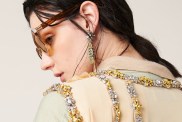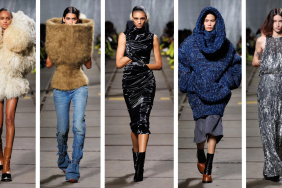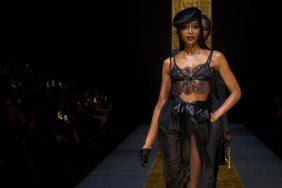About five years ago, the Manhattan native took a break from her fashion career to start a family; now, she’s returned to the design scene with a new collection for Spring 2014 (pictured here).
Earlier this week, we spoke with Roi about her comeback, her evolving design aesthetic and what it’s like to balance running a label with being a mom.
theFashionSpot: How did you make the decision to go on hiatus?
Alice Roi: There were multiple decisions but primarily it was based on the fact that we wanted to start a family. Now we have a lovely son — he’s five. It was always in the back of my mind to get back to designing, but…I don’t think anyone realizes how hard it is, but it’s a tough transition to become a mom. I guess that sort of answers the question of why I left and why it took so long. Obviously, I’ve always wanted to design, even when I was in diapers. I can’t stay away for too long.
tFS: Were you frightened at all, when you made the decision to start designing again?
AR: It’s frightening during and in its absence and coming back — it’s all frightening! I think it’s hard to come back, but that’s why I wanted to ease into it, rather than get right back into doing shows and the whole rigamarole. All the showiness. I wanted to come back to it from a very pure perspective and not just all the hoopla that surrounds fashion. First round, I was possibly too involved with it. Filing shoes before a show, stuff like that. I wanted to get back to the essence of designing, the reason why I love it. Being hands on and not just at some crazy party.

tFS: How much did you follow fashion the past five years? Were you looking at shows?
AR: I had this dilemma internally about whether I would take a break and not even like, read a magazine, or if I was going to pay really, really strict attention and absorb it all and keep it in the back of my mind for one day when I come back.
But it did feel like pressure sometimes, whenever I picked up a magazine. It was this, “Oh, look at all my friends at camp and I’m home for the summer” kind of feeling. So I tried not to look because it was painful. But occasionally I would look, it was hard for me not to. Even when The New York Times arrives, we’re reading it and I can’t help it, something that catches my eye in the Style Section and I read it. So although I wasn’t following it religiously —I wasn’t looking at shows and thinking about what everyone did for a particular season — I checked on the top layer of it. I looked to see what was going on, in a very vague way. But it was sort of this internal struggle: Am I going to look or not? So I just kept to the top layer.

AR: I feel like it’s changed a lot. Obviously what’s on all of our minds is retail and e-commerce. People are getting such great product online: It’s so customized and you can find exactly what you want. It’s changed a lot, both in terms of Internet shopping and the community around it. It almost feels like the retailers have catching up to do as far as what’s going on online and what people’s opinions are.
People are more individual. I think the individual style has gotten better. Risk-taking has gotten better. When I left the industry it was very formal, sort of like, “What jacket matches those pants?” “How can I merchandise this?” And retailers who ordered the collection always ordered the most basic thing. And in that way, times have changed. Because now they want the most out-there thing. The Internet helps because we’re seeing all these images of people pushing the envelope, fashion-wise. There’s an individuality which is emerging, which puts designers up against a wall and forces them to make better product. I think before, there was a rift between the retailer and customer. Because the retailer was just like, programmed to buy black pants. But now the customer will come in and say, “This is boring, I’m out of here.” Retailers are thinking more about the customer and less about the numbers and the higher-ups. The people have spoken, basically. That’s how the Internet has changed fashion.
tFS: You’ve launched your own e-commerce. How are you thinking about selling your own line on the Internet?
AR: The good news is for me and e-commerce is that I’ve always had a big fanbase but it’s been pretty much underground. They always wanted product but it’s pretty difficult to find the assortment. So it’s like, finally. It was a hard product to nail down. Now it’s available online.
We started very slow. The assortment is small because we want to be able to fulfill the orders properly and make sure that the integrity was there, and that we’re not just sending out lots of items but in bad quality. So we’re keeping it really tight with some horn cuffs, a few leather pieces and a few feminine blouses and dresses. I’m sure that will expand as time goes on, but we wanted to dip our foot in and really offer the best. I’m excited about it, because I really find that it’s hard to find that special something. For fans and for people who like this sort of offbeat femininity, it’s the perfect site.







